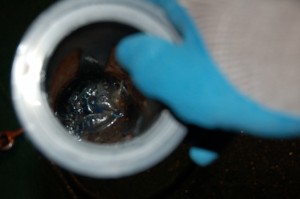S 34° 50’ 20.6″ E 27° 32’ 18.8″ – The first working day of this leg of the Malaspina expedition began with the splash of a Neuston net into the black water on the starboard side of the Hespérides before dawn on Sunday. The bosun, another operations officer, and a handful of technicians and scientists wearing life vests and helmets stood watch with arms folded under the warm yellow running lights of the ship. They were waiting in the rich wet air for a fine mesh net, hanging behind the two metal pontoons of the skate, to fill with creatures of the night.
Zooplankton, animals so small they must drift with the current, rise to the surface over the course of the night, so the research group which studies them, led on this leg by Jose Ángel Fernández Lamas, a technician at the Spanish Oceanographic Institute (IEO) in A Coruña, must wake before the sun to capture their tiny quarry. After ten or fifteen minutes of dragging the skate alongside the moving ship, the bosun instructs the crane operator to reel it in. The bosun, wearing a low-profile inflatable life vest and a white helmet over his navy work clothes, reaches out with a pike to bring the equipment within reach. Fernández sprays down the mesh with a hose, to ensure that everything captured ends up in a tube at the back of the net, which he then rushes to the laboratory at the deck level.
 The creatures in the sample tube squish one another into an indistinguishable mash. Fernandez separates them using a net with 5mm holes. The larger animals land in a basin in the workspace of Carlos Luis Cáceres Pérez, a grad student at the University of Oviedo. Cáceres must photograph each type of animal with a high-resolution macro lens and then fix the animals, depending on the day, with formaldehyde for taxonomic identification or with ethanol for genetic analysis, or by drying them for isotopic analysis. The creatures captured by a Neuston net live in the first few centimetres below the ocean’s surface, a volatile region where the atmosphere and the ocean mix continually.
The creatures in the sample tube squish one another into an indistinguishable mash. Fernandez separates them using a net with 5mm holes. The larger animals land in a basin in the workspace of Carlos Luis Cáceres Pérez, a grad student at the University of Oviedo. Cáceres must photograph each type of animal with a high-resolution macro lens and then fix the animals, depending on the day, with formaldehyde for taxonomic identification or with ethanol for genetic analysis, or by drying them for isotopic analysis. The creatures captured by a Neuston net live in the first few centimetres below the ocean’s surface, a volatile region where the atmosphere and the ocean mix continually.
That interaction is one of the targets of the Malaspina expedition, which has aims to document and try to understand many forms of global change in the ocean. Other research groups aboard are focused on atmospheric pollution and on pollution of the surface water, so surveying the biology at the interface is natural, says Jordi Dachs, of the Institute of Environmental Assessment and Water Research (IDAEA) in Barcelona and the scientific director of this leg of the cruise.
The Neuston net was just the first in a packed schedule yesterday. There are a total of 29 researchers and 4 technicians working in 6 research groups. Each group makes several daily observations, stretching from 4:30 in the morning until midnight.
Including the 57 Navy personnel and 4 journalists, there are 94 of us aboard, which is just about what Alessandro Malaspina had on each of his ships. The Hespérides’ sister vessel, the B./O. Sarmiento de Gamboa, is currently traversing the 24th parallel in the North Atlantic, also as part of the Malaspina project.
The Hespérides has been out of sight of the coast since Friday night. Last night on the bridge an officer told me we’re still in the shipping lanes which skirt South Africa and Madagascar bound for India and east Asia, but that in the next couple of days we’ll veer east along the 30th parallel into rarely trafficked, or studied, waters.
Meanwhile, today’s observations are in full swing and it’s time for me to visit another research group.
Previous post in this series:
Malaspina expedition: Shipping out (11 February 2011)
Images: Retrieving the Neuston net (top), the Neuston sample (middle), photographing the plankton before they deform (bottom). / Lucas Laursen
First published on Nature’s The Great Beyond blog: [html].
